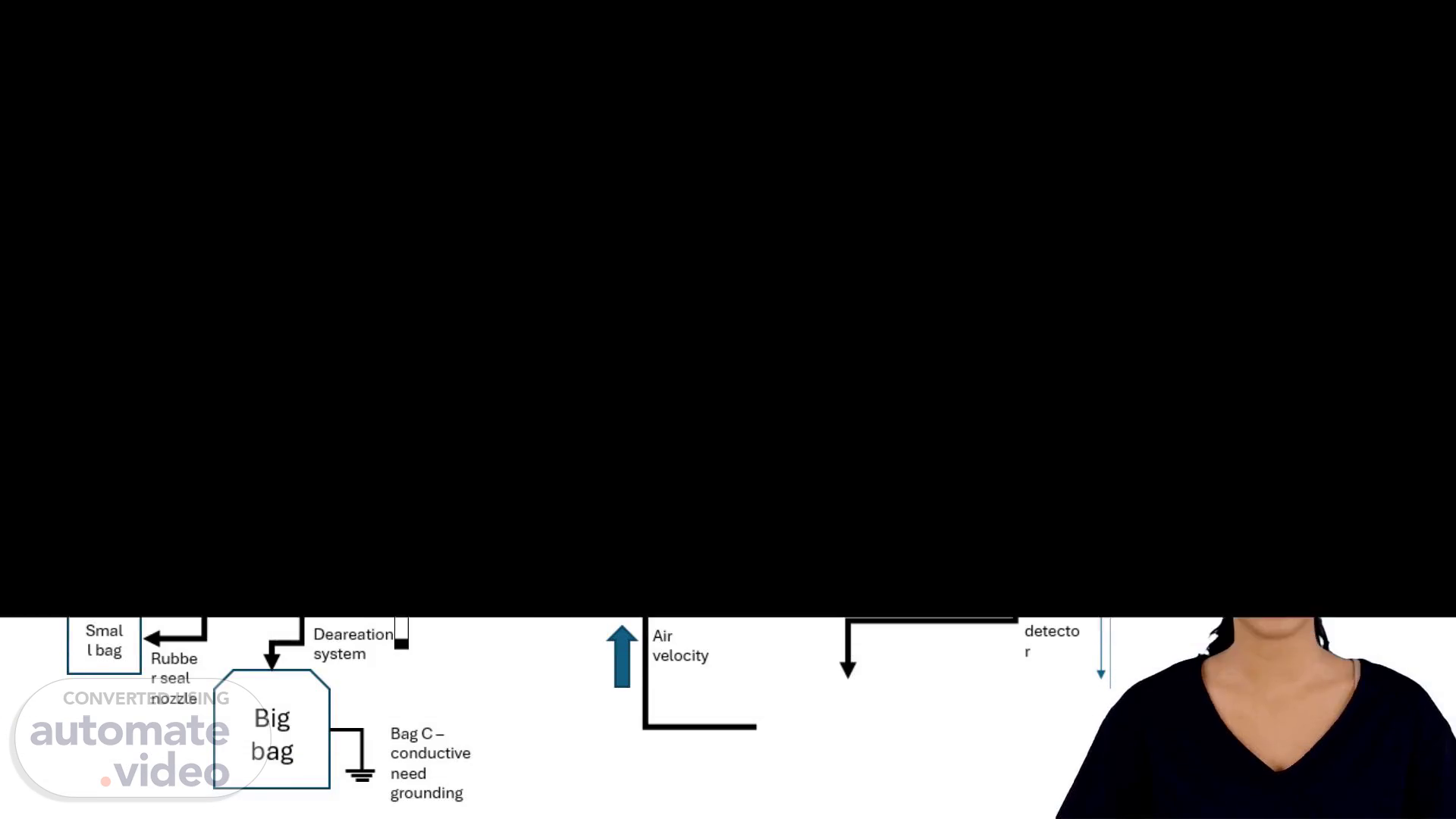Scene 1 (0s)
[Virtual Presenter] The dryer is a critical piece of equipment in our process, responsible for drying raw materials to the desired moisture level. The filter media, or FM, plays a crucial role in this process, ensuring that the dried material meets the required specifications. The silo and furnace, or FU, store raw materials and provide necessary heat for the drying process. A metal detector detects any metal particles in the raw materials, which could potentially cause damage to the equipment. Explosion vents are installed to prevent explosions from occurring within the dryer. Filter bags capture any dust or particles generated during the drying process. The deaeration system removes air from the system, preventing oxidation and corrosion. The manhole is kept closed to prevent accidental opening, which could lead to contamination or damage. Air velocity is monitored to ensure it remains within the acceptable range. Finally, rework, testing, and labeling systems are in place to ensure the dried material meets the required standards..
Scene 2 (1m 1s)
[Audio] Proper grounding and earthing of equipment and vessels are essential to prevent ignition sources. Eliminating static electricity sparks and electrical arcs through various measures is crucial. Regular maintenance and reporting of equipment failures can also help prevent mechanical contacts that could ignite a fire. Furthermore, installing metal detectors or divertors between the dryer and mill can significantly reduce the risk of ignition sources. By implementing these measures, we can minimize the likelihood of a dust fire or explosion occurring within the process equipment..
Scene 3 (1m 34s)
[Audio] The risk of fire and explosion inside process equipment, such as silos, dryers, and mills, can be prevented by reducing the amount of fresh air being fed to the fire. This can be achieved by stopping the FM, which prevents the feeding of more oxygen to the fire. An automatic and manually activated steam valve can also cut off the oxygen supply to the fire. Additionally, stopping the feeding of fuel to the fire by stopping the suction of FM, limiting the amount of fuel available, and segregating the process using the rotary valve are essential measures. Discharge to the dryer should also be stopped, either manually or through an interlock trigger. Containing the fire or smoldering material inside the equipment is crucial, and under no circumstances should anyone attempt to release burning or smoldering material into the workplace. Following all safety procedures and protocols is vital to ensure safety..
Scene 4 (2m 26s)
[Audio] To prevent ignition sources during rework, it is essential to ensure proper grounding and earthing of big bags and equipment. Limiting the rate of discharge from big bags reduces the accumulation of static charges. Fresh, warm, or hot powder should not be discharged into equipment, as this can lead to the buildup of static charges. No incompatible work, such as hotwork, should be performed near the rework area. When restarting the dryer operation, the bag discharge must be stopped and the hatch of the hopper must be closed. By following these measures, ignition sources can be effectively prevented, minimizing the risk of dust fires and explosions during rework..
Scene 5 (3m 7s)
[Audio] Prevent ignition sources such as static electricity sparks or electrical arcs by ensuring proper grounding and earthing of equipment and vessels. Minimize dispersion by immediately stopping equipment when there's a risk of explosion, using vacuum systems instead of compressed air to remove dust, and keeping operating vessel hatches closed. Minimize dust accumulation through daily housekeeping and thorough cleaning during annual shutdowns. Avoid hot work near process openings and ensure proper maintenance and reporting of equipment failures to prevent mechanical contacts that could ignite combustible dust..
Scene 6 (4m 21s)
[Audio] The dryer temperature interlocks prevent overheating of the dryer. When the temperature reaches 70°C, the PLC sends an alarm and requires operator intervention. At 75°C, the PLC also sends an alarm but closes the RX discharge valve and steam purge line. In extreme cases where the temperature exceeds 100°C, the PLC opens the fire extinguishing steam purge valve..
Scene 7 (4m 49s)
[Audio] The temperature interlocks in this dryer system ensure that operators are alerted when the temperature exceeds a certain threshold. At 70 degrees Celsius, the system triggers an alarm, requiring immediate operator intervention. As the temperature rises further to 75 degrees Celsius, the system takes additional action, closing the RX discharge valve and opening the steam purge line. This is a critical safety measure to prevent any potential damage or harm..
Scene 8 (5m 16s)
[Audio] The temperature and level interlocks in the dryer guarantee secure functioning. Upon reaching 75 degrees Celsius, the PLC triggers an alert and shuts down the RX discharge valve and steam purge line, thereby preventing any potential risks. At 100 degrees Celsius, the PLC activates the fire extinguishing steam purge valve. The level interlocks also significantly contribute to maintaining safety. Whenever the level drops beneath the minimum threshold, the PLC issues an alert and demands operator involvement, thus ensuring the dryer operates within a secure range..
Scene 9 (5m 53s)
[Audio] The final step in our safety measures is the dryer hatch open interlock system, which ensures that the dryer remains shut until it is safe to open it. Once opened, the fan stops immediately, and the hatch can only be unlocked after a 60-second delay, preventing any accidental opening of the hatch, which could lead to a release of hot materials. The dryer latch remains open until the mixer stop and discharge stop signals are received, and finally, the CCR PLC allows the hatch to be opened once all necessary conditions have been met..
